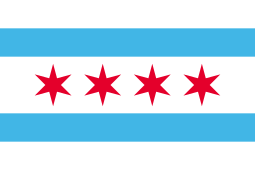Municipal Flag of Chicago
 |
|
| Adopted | Original, 1917; additional stars added, 1933 and 1939. |
|---|---|
| Design | Four red stars between two light blue horizontal bars on a white field |
| Designed by | Wallace Rice |
The municipal flag of Chicago consists of two blue horizontal stripes or bars on a field of white, each stripe one-sixth the height of the full flag, and placed slightly less than one-sixth of the way from the top and bottom. Between the two blue stripes are four red, six-pointed stars arranged in a horizontal row.
The flag, designed by Wallace Rice, was adopted in 1917 after Rice won the design competition for the flag. The three sections of the white field and the two stripes represent geographical features of the city, the stars symbolize historical events, and the points of the stars represent important virtues or concepts. The historic events represented by the stars are Fort Dearborn, the Great Chicago Fire of 1871, the World's Columbian Exposition of 1893, and the Century of Progress Exposition of 1933–34.
In a review by the North American Vexillological Association of 150 American city flags, the Chicago city flag was ranked second best with a rating of 9.03 out of 10, behind only the flag of Washington, D.C.
The three white background areas of the flag represent, from top to bottom, the North, West and South sides of the city. The top blue stripe represents Lake Michigan and the North Branch of the Chicago River. The bottom blue stripe represents the South Branch of the river and the "Great Canal", over the Chicago Portage. The lighter blue on the flag is variously called sky blue or pale blue; in a 1917 article of a speech by Rice, it was called "the color of water".
There are four red six-pointed stars on the center white stripe. Six-pointed stars are used because five-pointed stars represent sovereign states, and because the star as designed was not found on any other known flags as of 1917. From left to right:
...
Wikipedia
